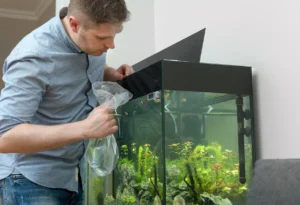How to Move a Fish Tank Without Killing Your Fish
Get Your Free Moving Estimate
Moving a fish tank is a big deal, especially when you think about the fish inside. You might remember the fun times watching them swim and the bond you share. The idea of upsetting their home can be scary.
But don’t worry! This guide will help you move your fish tank safely. You’ll learn how to do it right, whether you hire a pro or do it yourself. It’s all about keeping your fish safe during the move.

With the right steps, you can move your tank without stressing out your fish. Let’s get ready for this big change together.
Understanding the Importance of a Safe Move
Moving a fish tank is more than just shifting it from one spot to another. It needs careful planning to keep your fish safe. With the right steps, you can make sure your fish has a smooth move.
The Risks of Moving Your Fish Tank
Without proper prep, moving a fish tank can be risky. Fish can get stressed from sudden changes, which might make them sick or even kill them. This is a big worry.
Changes in water conditions during a move can also harm your fish. Sudden changes in temperature or pH levels can shock them. Plus, equipment failure, like a broken filter or heater, is another risk.
Getting a professional aquarium moving service can help avoid these dangers. They have the skills and tools to move your tank safely. Knowing these risks helps you plan a safe move for your fish.
Making a Relocation Plan
Creating a detailed plan for moving your aquarium is key. Start by checking out your current setup. Each part of your aquarium is important for your fish’s health. Knowing and recording these details will help make moving easier.
Assessing Your Current Setup
First, make a list of your aquarium’s setup. Think about the following:
- Size of your tank: Measure it and figure out the water volume. This affects how you’ll move it.
- Types of fish: Note the needs of each fish species. They might need special care during transport.
- Equipment needed: List must-haves like filters, heaters, and other important tools for your tank’s health.
- Special requirements: If some fish have special needs, make sure to include those in your plan.
Using resources from groups like the Pet Industry Joint Advisory Council can help. They offer tips for a successful move. This careful planning will help your fish stay healthy during the move.
Preparing Your Fish for the Move
Getting your fish ready for transport is key to their safety. This part talks about getting your fish used to a new place before moving day. The right setup and less stress make the journey safer for your fish.
Creating a Safe Transport Environment
Start by picking the right containers for your fish. Fish bags or strong plastic bins are great for moving fish. Make sure each container is clean and has good airflow. This keeps the water quality and oxygen levels up during the move.
To keep your fish calm, try these tips:
- Lowering light levels can help your fish feel more secure in their temporary environment.
- Keeping the water temperature stable is essential for reducing shock and discomfort.
- Avoid overcrowding in your containers to minimize stress and allow for easier handling.
When planning the move, look up safe fish transport tips. These steps help make the move smooth and keep your fish safe during the trip.
Also, explore how to move a hot tub without breaking your back.
Moving Your Fish Tank Components
When you plan to move your fish tank, it’s important to know how to disassemble it properly. This step helps you handle your fish tank parts safely. It also reduces the chance of damage during the move. By using the right methods, you can keep your aquarium in top shape.
Disassembling the Tank
Start by carefully taking apart the tank’s parts. Here’s what to do:
- First, turn off all equipment like filters, heaters, and lights.
- Then, remove decorations, plants, or substrate from the tank.
- Next, disconnect the filter and heater. Make sure they stay in the tank water to keep beneficial bacteria alive.
- Drain the aquarium water, but keep enough to cover the filter media.
- Finally, bundle cords together to avoid tangling during the move.
Handling your fish tank parts with care ensures they work well in your new setup. A well-planned disassembly keeps your fish healthy and makes the move smoother. Keeping some of the original tank water helps your beneficial bacteria thrive, easing the transition for your fish.
The Actual Move: Tips and Techniques
When moving your fish tank, knowing the details is key to keeping your fish safe. You might hire a professional aquarium moving company or do it yourself. Either way, using the right techniques is crucial for your fish and equipment’s safety.
Transporting Your Tank
Planning is vital when moving your tank. It’s important to keep it upright to avoid water spills and damage. Here are some tips for a safe move:
- Secure the tank: Use straps or soft padding to keep the tank steady in your vehicle. This stops it from moving or rolling.
- Optimal temperature: Make sure the containers with your fish stay at a stable temperature. This reduces stress and health risks.
- Limit movement: Use blankets or cushioning to lessen vibrations and movements that could harm your tank and fish.
- Consider professional help: Professional movers for aquariums have trained staff. They know how to safely move tanks and reduce risks.
By being organized and following these tips, you can move your fish tank safely. This lets you and your fish settle into your new home easily.
Setting Up Your New Tank
After arriving at your new place, it’s time to set up your fish tank. It’s important to do this right so your fish can thrive. Here are some tips to help you get everything ready before bringing in your fish.
Reassembling the Tank
Start by putting the tank parts back together. Make sure each piece is in place and works well. Before adding water, consider a few things:
- Look for any damage to your filters, heaters, and lights.
- Plan out your substrate and decorations. This makes your tank look good and gives your fish places to hide.
- Fill the tank slowly with water. This helps avoid disturbing the bottom and keeps your fish calm.
Then, adjust the water to match what it was before. Check the pH, ammonia, nitrites, and nitrates. Good water quality is key for your fish’s health. Let the equipment run for a few hours to get the water right.
Before you put your fish back in, check the tank one last time. Clean out any dirt or bad stuff that might have gotten in. Remember, be patient as you get ready for this big change. By following these steps, you’ll make sure your fish tank move goes smoothly and your fish stay healthy and happy.

Monitoring and Maintenance Post-Move
After moving your aquarium, keeping your fish healthy is crucial. Start by watching them closely. It’s important to check the water’s temperature, pH, and ammonia levels regularly. This helps you catch any changes that might harm your fish.
Changing how you feed your fish might be needed too. Fish can get stressed after a move, which might make them less hungry. If they’re not eating or seem stressed, feed them less until they get used to their new home. This helps them recover and stay healthy.
Always look for signs of illness in your fish after the move. Watch for changes in how they swim, their color, or any odd behavior. If you see something wrong, act fast. Reading about fish care from experts like the American Fisheries Society can help a lot. They provide tips to keep your aquarium thriving after the move.
Experts at Doorstep!
At Mustang Moving, we specialize in making your aquarium move as smoothly as possible. We know how vital it is to protect your fish during the transition, which is why our expert team handles every step with care. From securing your tank to safely transporting it, we ensure your aquatic friends arrive at their new home without stress.
With Mustang Moving, you can trust that your aquarium will be in the best hands, letting you focus on setting it up and keeping your fish healthy. Let us take the worry out of your move!
FAQ
How can I safely move my fish tank without harming my fish?
To move safely, think about hiring a company that specializes in aquariums. They know how to handle it. If you’re moving it yourself, get ready by knowing your fish’s needs. Set up a temporary home for them during the move.
What should I do to prepare my aquarium for transport?
First, make a plan for moving. Check your tank’s setup, including fish and equipment. Use special bags or buckets to help your fish adjust to a new place.
Should I disassemble my aquarium components before moving?
Yes, disassembling your tank is key. Carefully remove all parts, keeping some filter media in the tank water. This keeps beneficial bacteria and prevents damage.
What are the risks of not using a professional aquarium moving service?
Without a pro, risks include water changes, fish stress, and equipment failure. These can harm your fish, so consider professional help.
How do I monitor my fish’s health after the move?
Watch the water quality and your fish closely after moving. Adjust feeding and look for any changes in behavior. This helps your fish adjust well.
What are the best practices during the actual move of my aquarium?
Keep your tank upright and secure during transport. Use proper containers for your fish. If you can’t move it yourself, hire a trusted company.
How can I ensure a smooth setup of my aquarium in the new location?
Once at your new home, reassemble your tank carefully. Keep water quality perfect. Use resources from groups like the Marine Aquarium Societies of North America for tips.
